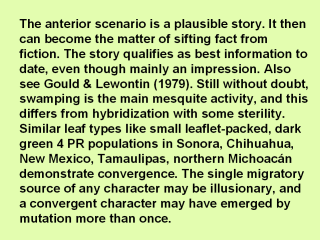 |
The desertic new niche studied here is seen as
expanding north and northeast of Guaymas, and in distant parts of Mexico by
the increasing presence of small-leaved invaders. Other indicators of severe
desert like Larrea tridentata are increasingly successful by desert niche
expansion. Clearly, the genetics and the ecology go hand-in-glove.
Irrigation makes the leaf larger almost immediately. It is expected to make
it larger over a few decades. It can become a matter of separating genotype
from phenotype, realizing that new types like Tiny arise by mutation,
selection and fixation, and that the older types are facing extinction as
the environment changes radically by manmade hydrolics, mostly lowering the
watertable.
|
